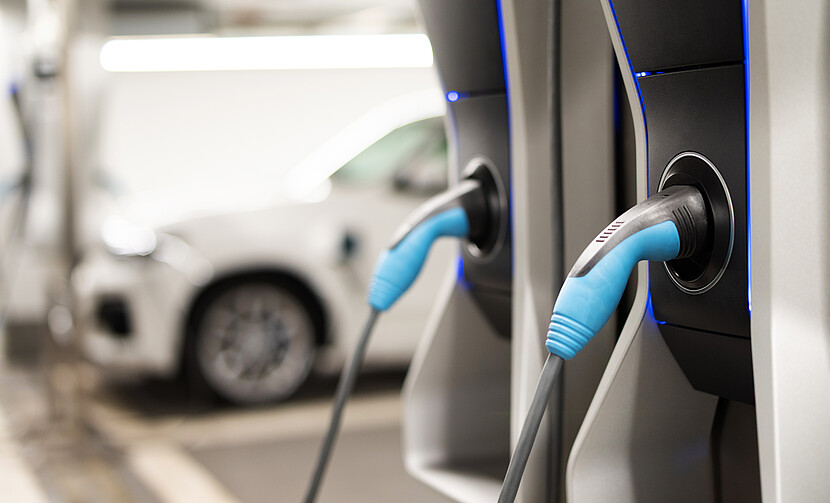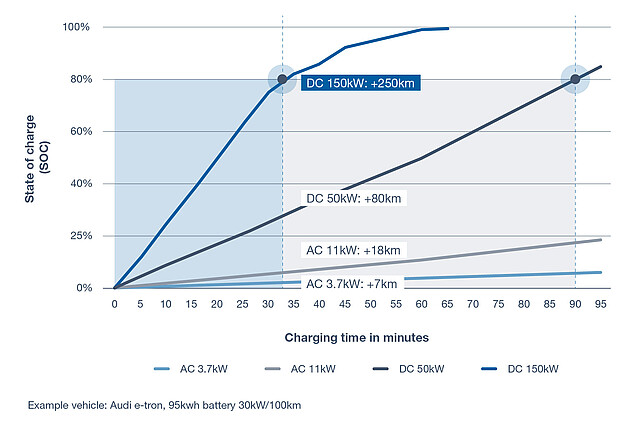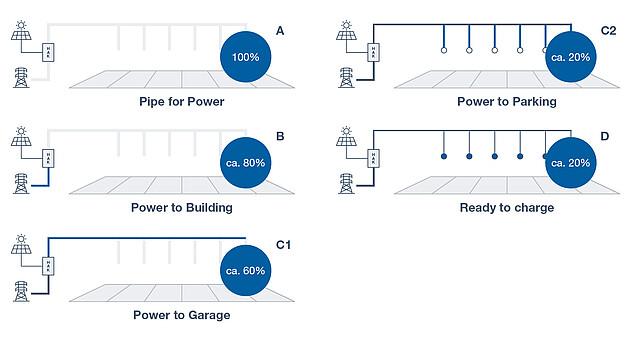Sales of electric vehicles have increased worldwide. 25% of cars sold in Switzerland in 2022 can be charged via a power socket. One in six new cars sold is powered exclusively by electricity. But how are all these vehicles getting supplied with electricity?
The automotive industry is changing like never before, with every manufacturer increasingly focusing their attention on electric vehicles. This can be attributed to both emissions regulations and the opportunities offered by the latest technological innovations. Furthermore, the increased demand for electric vehicles is making manufacturers rethink their approach. The system for procuring fuel for internal combustion engines has been fully established and strictly regulated over many decades. Countless petrol stations sell fossil fuel, enabling vehicle owners to refuel at the pump whenever needed. But how does this work in terms of electric vehicles?
The process is identical to refuelling with fossil fuel, yet there are significant differences. Electric vehicles can be charged via any standard household socket. However, the charging process takes several hours depending on the charging capacity. This is not particularly efficient and highlights the urgent need to create new charging infrastructures.
Diverse charging systems
Charging points are divided into AC (alternating current) and DC (direct current) varieties. AC charging is facilitated via charging cables and wall boxes. The charging capacity is relatively slow with up to 50kW, which means this option is suitable when vehicles remain in the same place for several hours. This is usually the case for charging points that are installed in homes and offices.
DC charging can currently provide up to 300kW of power and capacity is continuing to rise. A rapid charger will charge a car from 10% to over 80% within 20 to 30 minutes. These charging points are useful for longer trips or during extended visits away from home when the car is immobile for a while, such as during trips to the shops, cinema or restaurants.
The cost of providing a charging infrastructure varies very widely. While AC charging is not expensive to set up at around CHF 1,500 to CHF 2,000, rapid charging points are priced at approx. CHF 100,000 per charging point. This is due to the complex infrastructure, power provision and the charging technology.
This is why rapid charging is generally only available in public spaces. Every e-car driver should have the best possible access to charging facilities, and this is very important for the economic viability of e-mobility. Public charging points may be provided on private property as long as unrestricted access is provided, such as in a car park operated by a store or shopping centre, or in a multi-storey or public car park.
AC charging is predominantly used in private residential buildings and office complexes. These users remain in the same place for several hours and do not generally need to fully recharge their vehicles quickly.
The boom in electric cars was fuelled by models such as the Tesla Model S. These vehicles were in a higher price bracket and their buyers usually owned their own homes and charging facilities. Now that e-vehicles are available in medium and lower price categories, they are becoming increasingly attractive to tenants who are not easily able to install home charging points.
Similar to a conventional petrol-powered car, an electric car can be charged at a public charging point at a petrol station. As at the end of 2022, around 12,600 public charging points had been installed in Switzerland. Around 62% of the charging points are AC chargers and 38% are DC rapid chargers. Even though the DC charging option is important to ensure sufficient coverage, the ability to charge cars at home or in the office is necessary for the purposes of market penetration. Owners of rental and commercial property are now being asked to meet these emerging needs.
Requirements for property owners
Property owners need to consider several questions before installing charging infrastructure for the first time.
Should I invest myself or offer a charging facility through a service provider?
On the one hand, there is the option of investing in the charging infrastructure and generating additional income through rentals. Alternatively, you can appoint a service provider to handle the installation, operation and billing if you do not want to manage the infrastructure yourself.
If you decide to invest, you need to be clear about the type of charging infrastructure you need to install.
If the demand for rapid charging stations is high, partnering with a specialist provider can be advantageous. However, if only slow charging points are required, the idea of investing can be more appealing.
How many parking spaces need to be equipped with charging points?
There are basically two options: Pool parking spaces that can be used when the vehicles are being charged or individually allocated parking spaces that are rented by tenants. If considering the pool parking option, it is important to define precise rules for use to ensure that the charging point is available to all users as much as possible. When providing individually allocated parking spaces, it is important to carefully manage the power supply so that the available capacity can be used wisely. In addition, care must be taken to ensure that individual parking spaces can be easily switched inside underground parking garages. This must be contractually agreed.
Which installation level should be implemented?
A: Pipe for Power: Empty conduits are installed to allow for future installations
B: Power to Building: An electric supply is fed into the building for e-charging purposes
C1: Power to Garage: Power is routed to parking spaces inside the building
C2: Power to Parking: A mounting plate is pre-installed next to the parking spaces
D: Ready to charge: Wall boxes are assembled ready for immediate use
It is not advisable to equip all parking spaces with wall boxes as a matter of principle. The supply of e-parking spaces should be expanded as needed. In 2022, approximately 179,000 electric and plug-in hybrid vehicles were registered, which corresponds to an “EV quota” of around 2.3%. However, around 56,000 cars were introduced in 2022 alone, showing that the demand for charging points is growing enormously.
In the coming years, there will be an even higher demand for e-parking spaces in residential and commercial buildings. Property owners need to be prepared to meet this demand, otherwise, their properties will lose their attractiveness.
in the SF Retail Properties Fund, the quota for electric parking spaces for new buildings and existing properties was specified. In recent months, concepts for e-mobility have been developed together with Energie Zukunft Schweiz so that the roll-out can start in the coming months following initial test installations. The concepts stipulate that AC charging points will be installed in residential and commercial properties. Public rapid charging points will be installed over the next few years in properties used for retail purposes. This supports the development of e-mobility and moves us closer towards our innovation goals.


